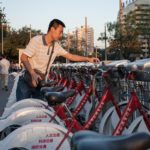
According to the United Nations World Urbanization Prospects, cities will add over 2.5 billion people in the next 40 years, with 90% of this growth coming from cities in emerging economies. China and India alone are expected to add 276 million and 218 million urban ...


Startups like Uber are revolutionizing personal transport in cities worldwide, providing on-demand services at a relatively low price. Can the same thing be done for bus transport? Imagine requesting a bus from your phone, and having it drop you off ...


When deciding between modes of transport, travelers consider several variables, typically including convenience, cost, time, reliability, and comfort. Another consideration – which is particularly important for women – is perceived safety. No one prefers public transport if it requires walking ...


EMBARQ India spoke with Jyot Chadha, head of EMBARQ India’s Initiative to Catalyze Urban Innovations, about the launch of a new Data Visualization Challenge, which encourages citizens to use publicly released data to create data visualizations that shed light on ...


This is the sixth entry in the Urbanism Hall of Fame series, exclusive to TheCityFix. This series is intended to inform people about the leading paradigms surrounding sustainable transport and urban planning and the thinkers behind them. By presenting their many ...


This summer, Indian Prime Minister Narendra Modi announced plans to build ‘100 smart cities’ across India in an effort to take advantage of the country’s recent urban boom and catalyze investment in Indian cities. His initiative will cost the government 1.15 ...


CNN recently described Cape Town, South Africa as being in the midst of a “vegoultion,” with hundreds of new community gardens and urban farms popping up throughout the city in recent years. The city’s “Green Clusters” are helping to improve ...


Every day, Mumbai residents are being squeezed out of spaces to walk or cycle by the sheer pressure of cars, whose numbers are growing rapidly each year. A recent report by the Munich-based global consultancy Roland Berger Strategy Consultants stated that ...


Editor’s note: The submission period has now closed. We invite you to register to attend Transforming Transportation 2015 here. Do you have big ideas for “what’s next” in sustainable mobility and urban development? It’s time to put them to the ...


The worst drought to grip São Paulo, Brazil and neighboring states in 80 years is wreaking havoc on the local population. As of late October, key reservoirs hold less than two weeks’ worth of drinking water. Schools and health centers are closing early, ...

Page 131 of 348« First...1020...130131132...140150...Last »